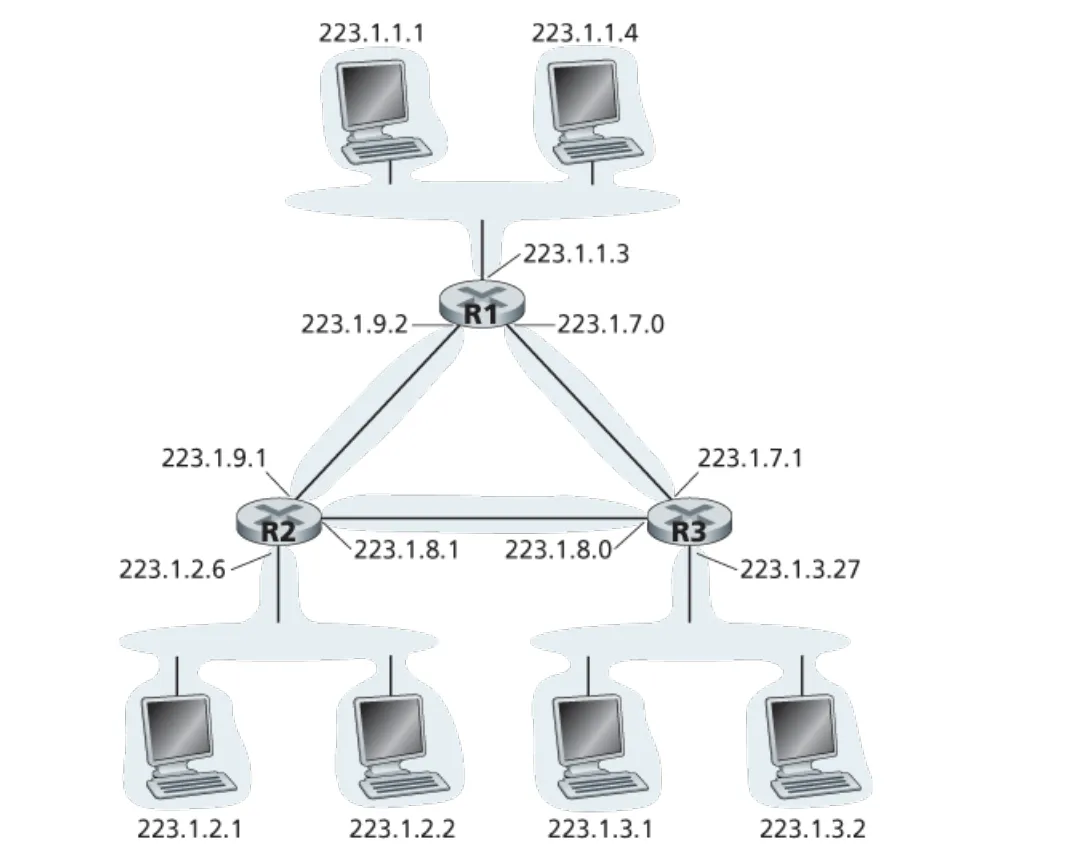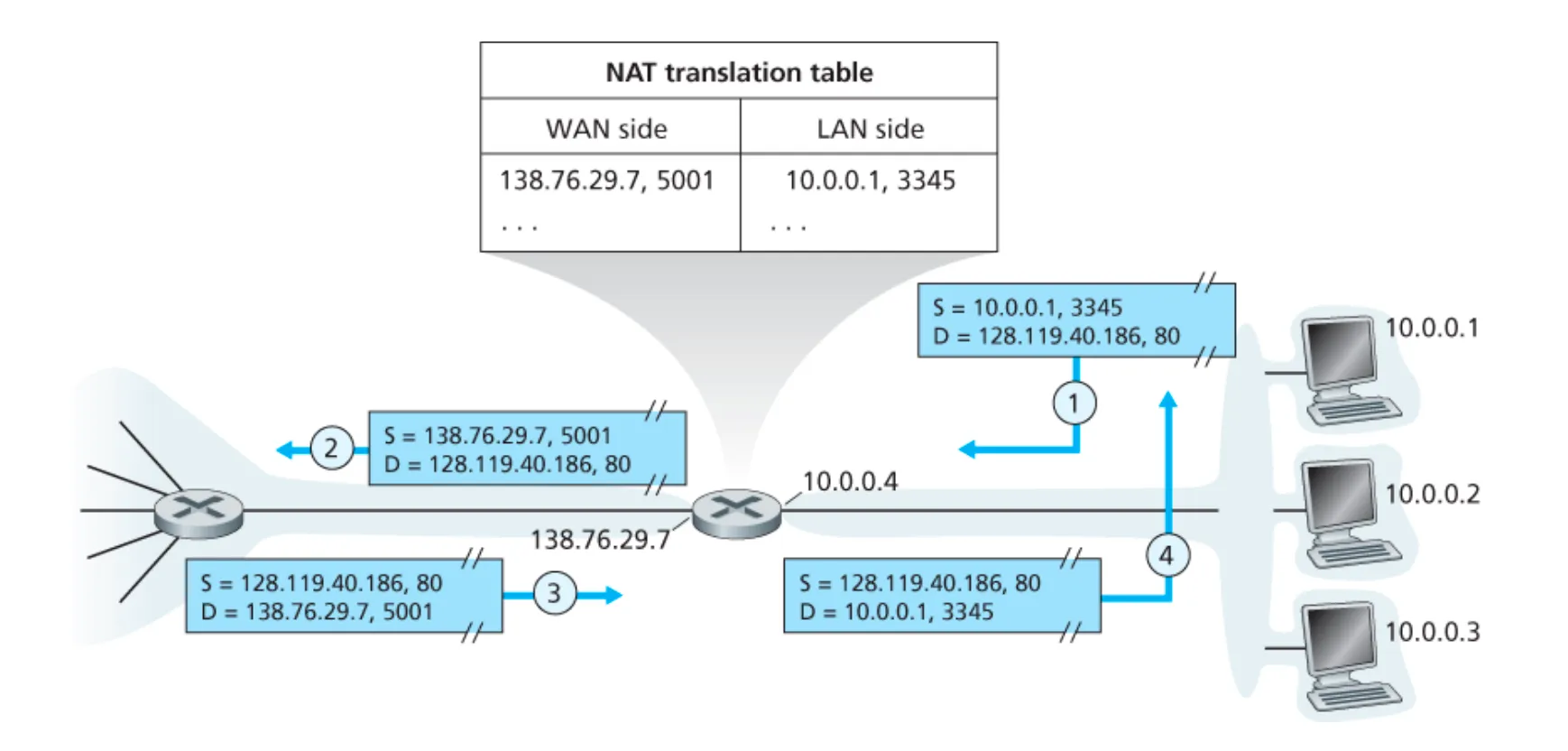Computer Networking: Network Layer Data Plane
计算机网络:网络层 数据平面
Network layer overview
Two key network layer functions: forwarding and routing.
- Data plane
- local, per-router function
- Control plane
- network-wide logic
Best effort service: simplicity of mechanism, sufficient provisioning of bandwidth, replicated application-layer distributed services, congestion control of “elastic” services.
Router
Longest prefix matching
When looking for forwarding table entry for given destination address, use the longest address prefix that matches destination address.
Switching fabric
Output & input port queuing.
How much buffering?
A recent recommendation: with N flows, buffering equal to
Scheduling policy
- FCFS
- priority
- round-robin
- weighted fair queuing
IP
The Internet protocol
IP addressing
IP address: 32 bit identifier associated with each host or router interface.
How to get one? Via DHCP
DHCP: Dynamic Host Configuration Protocol
- host broadcasts DHCP discover message
- DHCP server responds with DHCP offer message
- host requests IP address: DHCP request message
- DHCP server sends address: DHCP ACK message
DHCP: more than IP addresses
- address of first-hop router for client
- name and IP address of DNS server
- network mask (indicating network versus host portion of address)
NAT
Network address translation
The router maps each host in subnet to a port of itself.
IPv6
Transition from IPv4 to IPv6: tunneling and encapsulation

SDN
Software defined networking
Exercise
Chapter 4
P4
Consider the switch shown below. Suppose that all datagrams have the same fixed length, that the switch operates in a slotted, synchronous manner, and that in one time slot a datagram can be transferred from an input port to an output port. The switch fabric is a crossbar so that at most one datagram can be transferred to a given output port in a time slot, but different output ports can receive datagrams from different input ports in a single time slot. What is the minimal number of time slots needed to transfer the packets shown from input ports to their output ports, assuming any input queue scheduling order you want (i.e., it need not have HOL blocking)? What is the largest number of slots needed, assuming the worst-case scheduling order you can devise, assuming that a non-empty input queue is never idle?

The minimal number of time slots needed is 3. The scheduling is as follows.
Slot 1: send X in top input queue, send Y in middle input queue.
Slot 2: send X in middle input queue, send Y in bottom input queue.
Slot 3: send Z in bottom input queue.
Largest number of slots is still 3. Actually, based on the assumption that a non-empty input queue is never idle, we see that the first time slot always consists of sending X in the top input queue and Y in either middle or bottom input queue, and in the second time slot, we can always send two more datagram, and the last datagram can be sent in third time slot.
NOTE: Actually, if the first datagram in the bottom input queue is X, then the worst case would require 4 time slots.
P5
Consider a datagram network using 32-bit host addresses. Suppose a router has four links, numbered 0 through 3, and packets are to be forwarded to the link interfaces as follows:

a.
| Prefix Match | Link Interface |
|---|---|
11100000 00 | 0 |
11100000 01000000 | 1 |
1110000 | 2 |
11100001 1 | 3 |
| otherwise | 3 |
b.
Prefix match for first address is 5th entry: link interface 3
Prefix match for second address is 3rd entry: link interface 2
Prefix match for third address is 4th entry: link interface 3
P7
Consider a data gram network using 8-bit host addresses. Suppose a router uses longest prefix matching and has the following forwarding table:

For each of the four interfaces, give the associated range of destination host addresses and the number of addresses in the range.
| Destination Address Range | Link Interface |
|---|---|
11000000 through 11011111 (32 addresses) | 0 |
10000000 through 10111111 (64 addresses) | 1 |
11100000 through 11111111 (32 addresses) | 2 |
00000000 through 01111111 (128 addresses) | 3 |
P12
Consider the topology shown in Figure 4.20. Denote the three subnets with hosts (starting clockwise at 12:00) as Networks A, B, and C. Denote the subnets without hosts as Networks D, E, and F.
a. Assign network addresses to each of these six subnets, with the following constraints: All addresses must be allocated from 214.97.254/23; Subnet A should have enough addresses to support 250 interfaces; Subnet B should have enough addresses to support 120 interfaces; and Subnet C should have enough addresses to support 120 interfaces. Of course, subnets D, E and F should each be able to support two interfaces. For each subnet, the assignment should take the form a.b.c.d/x or a.b.c.d/x – e.f.g.h/y.
b. Using your answer to part (a), provide the forwarding tables (using longest prefix matching) for each of the three routers.

a.
Subnet A: 214.97.255/24 (256 addresses)
Subnet B: 214.97.254.0/25 - 214.97.254.0/29 (128-8 = 120 addresses)
Subnet C: 214.97.254.128/25 (128 addresses)
Subnet D: 214.97.254.0/31 (2 addresses)
Subnet E: 214.97.254.2/31 (2 addresses)
Subnet F: 214.97.254.4/30 (4 addresses)
b. To simplify the solution, assume that no datagrams have router interfaces as ultimate destinations. Also, label D, E, F for the upper-right, bottom, and upper left interior subnets, respectively.
Router 1
| Longest Prefix Match | Outgoing Interface |
|---|---|
| 11010110 01100001 11111111 | Subnet A |
| 11010110 01100001 11111110 0000000 | Subnet D |
| 11010110 01100001 11111110 000001 | Subnet F |
Router 2
| Longest Prefix Match | Outgoing Interface |
|---|---|
| 11010110 01100001 11111111 0000000 | Subnet D |
| 11010110 01100001 11111110 0 | Subnet B |
| 11010110 01100001 11111110 0000001 | Subnet E |
Router 3
| Longest Prefix Match | Outgoing Interface |
|---|---|
| 11010110 01100001 11111111 000001 | Subnet F |
| 11010110 01100001 11111110 0000001 | Subnet E |
| 11010110 01100001 11111110 1 | Subnet C |
P15
Suppose datagrams are limited to 1,500 bytes (including header) between source Host A and destination Host B. Assuming a 20-byte IP header, how many datagrams would be required to send an MP3 consisting of 5 million bytes? Explain how you computed your answer.
MP3 file size = 5 million bytes. Assume the data is carried in TCP segments, with each TCP segment also having 20 bytes of header. Then each datagram can carry 1500 - 40 = 1460 bytes of the MP3 file.
Number of datagrams required: .
All but the last datagram will be 1,500 bytes; the last datagram will be 960+40 = 1000 bytes. Note that here there is no fragmentation – the source host does not create datagrams larger than 1500 bytes, and these datagrams are smaller than the MTUs of the links.
P16
Consider the network setup in Figure 4.25. Suppose that the ISP instead assigns the router the address 24.34.112.235 and that the network address of the home network is 192.168.1/24.

a. Assign addresses to all interfaces in the home network.
b. Suppose each host has two ongoing TCP connections, all to port 80 at host 128.119.40.86. Provide the six corresponding entries in the NAT translation table.
a. Home addresses: 192.168.1.1, 192.168.1.2, 192.168.1.3 with the router interface being 192.168.1.4
b. NAT Translation Table
| WAN side | LAN side |
|---|---|
| 24.34.112.235, 4000 | 192.168.1.1, 3345 |
| 24.34.112.235, 4001 | 192.168.1.1, 3346 |
| 24.34.112.235, 4002 | 192.168.1.2, 3345 |
| 24.34.112.235, 4003 | 192.168.1.2, 3346 |
| 24.34.112.235, 4004 | 192.168.1.3, 3345 |
| 24.34.112.235, 4005 | 192.168.1.3, 3346 |
P18
In this problem we’ll explore the impact of NATs on P2P applications. Suppose a peer with username Arnold discovers through querying that a peer with username Bernard has a file it wants to download. Also suppose that Bernard and Arnold are both behind a NAT. Try to devise a technique that will allow Arnold to establish a TCP connection with Bernard without application specific NAT configuration. If you have difficulty devising such a technique, discuss why.
It is not possible to devise such a technique. In order to establish a direct TCP connection between Arnold and Bernard, either Arnold or Bob must initiate a connection to the other. But the NATs covering Arnold and Bob drop SYN packets arriving from the WAN side. Thus neither Arnold nor Bob can initiate a TCP connection to the other if they are both behind NATs.
P19
Consider the SDN OpenFlow network shown in Figure 4.30. Suppose that the desired forwarding behavior for datagrams arriving at s2 is as follows:

- any datagrams arriving on input port 1 from hosts h5 or h6 that are destined to hosts h1 or h2 should be forwarded over output port 2;
- any datagrams arriving on input port 2 from hosts h1 or h2 that are destined to hosts h5 or h6 should be forwarded over output port 1;
- any arriving datagrams on input ports 1 or 2 and destined to hosts h3 or h4 should be delivered to the host specified;
- hosts h3 and h4 should be able to send datagrams to each other.
Specify the flow table entries in s2 that implement this forwarding behavior.

P20
Consider again the SDN OpenFlow network shown in Figure 4.30. Suppose that the desired forwarding behavior for datagrams arriving from hosts h3 or h4 at s2 is as follows:
- any datagrams arriving from host h3 and destined for h1, h2, h5 or h6 should be forwarded in a clockwise direction in the network;
- any datagrams arriving from host h4 and destined for h1, h2, h5 or h6 should be forwarded in a counter-clockwise direction in the network.
Specify the flow table entries in s2 that implement this forwarding behavior.
